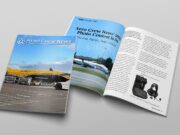
Flying demands your attention in a thousand different ways, and background noise adds to the challenge. Staying sharp and focused is not always easy, but it is a skill you can develop. “What do you think of that?” The question catches you off guard – you have no idea what they are talking about. Sound familiar? We all struggle with concentration sometimes. Maintaining focus can be challenging in a noisy training simulator, dealing with constant interruptions, or finding your mind drifting during a pre-briefing. This article covers six tips to help you improve your concentration.
Maintaining focus is not always easy. Some people can concentrate and focus longer than others, but no one can retain peak focus indefinitely. The ability to concentrate varies with the task – from a few minutes to several hours. For example, complex and critical tasks such as flight planning are more often manageable to focus on for several hours. Tasks that are more monotonous and less engaging tend to result in reduced concentration and increased distractions, making it hard to stay focused. For instance, even though the information is essential, watching training videos on standard operating procedures while maintaining protracted concentration can be challenging.
In addition to a healthy lifestyle with sufficient sleep, regular exercise, and nutritious eating, three factors significantly impact focus:
- Passion. Staying fully engaged during an exciting flight maneuver is easier than maintaining attention during a routine pre-flight briefing.
- Expertise & Skill. Like athletes who reach peak concentration during competitions due to their expertise, the more proficient you are at flying, the easier it becomes to focus.
- Managing distractions is crucial. It is challenging to concentrate on your duties when there is chatter or other disturbances around you.
Fortunately, focusing is a skill that can be developed. With practice, you can significantly enhance your ability to concentrate.
Six Tips
1. Make Lists
Making lists can be a powerful tool for maintaining focus when your mind is cluttered with tasks and responsibilities. By writing down everything you need to do, you offload mental burdens and create a clear roadmap for action. This frees up mental space, allowing you to concentrate more effectively on the task without the distraction of trying to remember other things you need to accomplish. Keep the list ready and add tasks immediately if something comes to mind. This will prevent you from dwelling on the topic.
2. Loss of Focus
Losing focus can result in behaviors and cues that indicate distraction, disengagement, or mental wandering, ultimately hindering effective communication and understanding.
If you notice your focus slipping, take proactive steps to engage your mind. Instead of allowing distractions to take over, acknowledge the loss of focus and actively involve yourself in the task. For instance, consider creating a mind map to visually highlight key points and concepts in meetings, which can help reinforce understanding and retention. In one-on-one discussions, maintain focus by asking questions and periodically summarizing the conversation. Through active participation, you can boost concentration and productivity across different scenarios.
3. Interval Training
To improve concentration, try to train your brain to focus for a short time. This is how it works:
- Try focusing on tasks using a structured schedule with short work intervals.
- Start with focused sessions of ten minutes, then take a five-minute break.
- Gradually increase focus time to 12 to 15 minutes, and beyond.
- During breaks, switch tasks or take a brief walk for mental refreshment.
- Stick to this routine consistently to build concentration and productivity.
For example, when studying, a structured schedule with short work intervals boosts concentration and learning. Start with ten-minute focused sessions, followed by a five-minute break. Gradually extend session times to 12 or 15 minutes. During breaks, switch tasks or refresh mentally with activities like reviewing notes or taking a short walk.
Pro Tip: Once the interval training is achieved, the next step would be the implementation of the Pomodoro Technique, which breaks work into focused intervals followed by short breaks. Here's how to do it:
- Set a timer for a focused work interval (pomodoro): Choose a task and set a timer for intense focus, typically 25 minutes.
- Work on the task without interruption: During the focused interval, work solely on the chosen task, avoiding distractions and maintaining concentration.
- Take a break: When the timer goes off, take a short break (maximum of five minutes). Use this time to get a coffee, relax, or do something enjoyable to refresh your mind.
- Repeat the cycle: After the break, return to the task for another focused interval. Repeat this cycle of work and break periods until you've completed four pomodoros (aka work intervals).
Take a longer break: After four pomodoros, take a longer break, between 15-30 minutes, to recharge before starting another set of focused intervals.
By breaking work into manageable intervals and interspersing them with short breaks, the Pomodoro Technique can help increase focus, productivity, and motivation.
4. STOP- Technique
Utilize the STOP technique. It is common for the mind to wander when focus is needed.
Each time you notice your mind drifting, mentally interrupt the thought process by saying “Stop,” and redirecting your attention to the task. The STOP method (see the acronym defined below) is a four-step mindfulness technique designed to help regain focus amid daily challenges:
- Stop: Pause whatever you are doing or thinking.
- Take a breath: Take a moment to breathe deeply and center yourself.
- Observe: Notice your thoughts, feelings, and bodily sensations without judgment.
- Proceed mindfully: After acknowledging your present experience, choose how to respond intentionally.
With practice, you will become better at quickly refocusing. Do not waste energy suppressing distracting thoughts – simply acknowledge them with STOP and resume the original task.
5. Set Aside Worry Time
Managing worries is crucial for maintaining focus. Allocate a specific time each day dedicated to addressing stress and concerns. When feeling worried during work hours, remind yourself that worrying is reserved for this designated time. By setting aside worry time, you create a structured approach to managing anxieties, allowing you to fully address them without interfering with productivity.
If you find it challenging to fill the allocated worry time, consider shortening it. This adjustment ensures that the time set aside is productive and meaningful. Writing down worries temporarily alleviates them, enabling you to concentrate better on your tasks.
Read more tips about worrying and setting aside worry time.
6. Incentivize Yourself
If motivation is lacking, this is an excellent opportunity to offer yourself incentives. Implementing reward systems can significantly enhance motivation and attention span. Consider promising yourself a reward upon completing a specific task. Setting clear goals and attaching meaningful rewards to their achievement creates a powerful incentive structure to keep yourself motivated and focused.
Here are a few examples of effective and healthy rewards:
- Physical activity: Take a break with a walk, jog, or bike ride to release endorphins and boost mood.
- Nutritious snacks: Enjoy fresh fruit, nuts, or yogurt for sustained energy without sugar crashes.
- Quality time with friends and family: Do something fun with family or friends, such as games or hikes, for meaningful connections.
- Self-care rituals: Treat yourself to a bath, an episode of your favorite series, or a good book.
- Mindfulness practice: Invest time in mindfulness or meditation to reduce stress (and help with focus!)
These healthy rewards promote well-being while incentivizing goal achievement.
Final Thoughts
Ensuring focus is essential for effective communication, safety, and efficiency. Yet, maintaining focus and motivation can pose challenges for anyone.
There is help to assist you in navigating these challenges by exploring personalized techniques tailored to your needs. Together with a professional, you will identify and address any factors affecting your focus while crafting strategies to enhance your performance. Whether it's managing distractions, alleviating anxiety, or boosting cognitive skills, the goal is to equip you with the tools necessary for success.
Emerald Mental Health supports pilots and aviation professionals with customized strategies to enhance focus and motivation through counseling and mental health coaching. Take the first step towards improved focus by scheduling a free consultation via email at [email protected] or visiting www.emeraldmentalhealth.com.
Sources:
Ferguson, S. (2022, December 20). 4 Quick Mindfulness Techniques. Psych Central. https://psychcentral.com/health/4-quick-mindfulness-techniques
Gupta, S. (2022, December 19). The Pomodoro Technique: History, Steps, Benefits, and Drawbacks. Verywell Mind. https://www.verywellmind.com/pomodoro-technique-history-steps-benefits-and-drawbacks-6892111















































